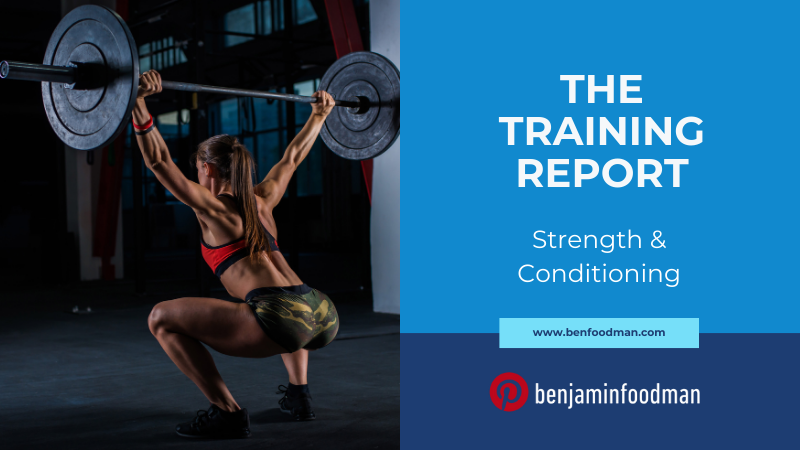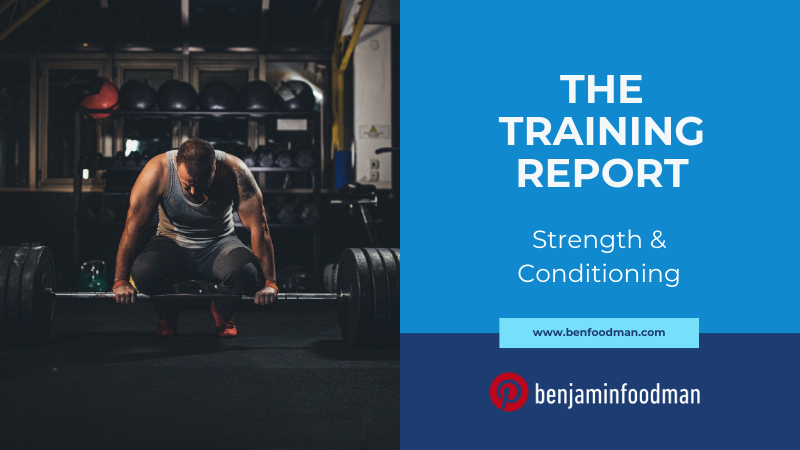Strength & Conditioning - Exercise Science Periodization Strategies Part II. Athlete Muscle Gain & Hypertrophy Training
About the Author
Ben Foodman is a licensed psychotherapist & performance specialist. He owns his private practice located in Charlotte North Carolina where he specializes in working with athletes to help them overcome mental blocks (the yips), PTSD, ADD / ADHD and achieve flow states through the techniques of Brainspotting & Neurofeedback. If you are interested in services, use the link here! Enjoy the article below!
Table Of Contents
Introduction: Strength & Conditioning Considerations For Athletes And Hypertrophy Training
Part I. Nutritional Considerations For Athletes & Hypertrophy Training
Part II. Weightlifting Periodization Considerations For Athletes And Hypertrophy Training
Part IV. Final Considerations For Physique Athletes On Hypertrophy
Introduction: Strength & Conditioning Considerations For Athletes And Hypertrophy Training
When athletes are deciding how they want to improve in their performance, there are many different considerations they have to analyze. An obvious area of their training is deciding what type of strength & conditioning protocols make the most sense to focus on. Endurance athletes will utilize exercises that train their heart rate zones, while Olympic-style weightlifters will emphasize longer rest periods in between lifting heavy weightlifting sets. But one area where almost all athlete populations benefit from is hypertrophy training (AKA increasing muscle mass).
For this issue of the Training Report I am going to discuss some hypertrophy training considerations that all athletes would benefit from knowing. We will first review the National Strength & Conditioning Association’s recommendations on nutrition performance for hypertrophy training, then we will review weightlifting considerations that all athletes should factor into their hypertrophy training, and finally we will review a sample program that athletes can use as a reference point. Let’s begin by exploring some of the literature around nutrition performance and hypertrophy training.
Part I. Nutritional Considerations For Athletes & Hypertrophy Training
One of the most significant factors that will affect the outcomes of hypertrophy training are the nutrition protocols that athletes use. Unfortunately this is also one of the more controversial areas in exercise science where heated debates are a regular occurrence. However there are some sources of information that have high degrees of credibility, one of those sources being the National Strength & Conditioning Association (NSCA). Per the NSCA: If athletes increase their calorie intake dramatically and consistently, they could gain more fat than they would like. A general guideline, which should be adjusted based on the athlete, is to consume approximately 500 additional calories per day in order to gain weight. Eating larger portion sizes, increasing meal frequency, and focusing on choosing calorie-dense foods are all strategies that can help an athlete gain weight. In addition to increasing total calorie intake, athletes should ensure that they are eating enough protein to maximize gains in lean body mass: 1.5 to 2.0 g per kilogram body weight per day. Increasing an athlete’s protein intake may make weight gain tough, given the profound effect that protein has on satiety, as well as the increased thermic effect of feeding associated with higher protein diets. However, overfeeding proteins is advantageous if the athlete can sustain the diet.
NSCA’s Simple Guidelines For Nutrition For Hypertrophy
Between 30 and 100 grams of high-glycemic carbohydrates should be consumed after muscle-damaging exercise to reduce muscle protein breakdown.
After resistance training, younger individuals should consume at least 20 to 25 grams (providing about 8.5 to 10 grams of essential amino acids) of a high-quality, high-leucine protein (2-3 grams), while older adults should consume 40 grams or more to maximally stimulate muscle protein synthesis in the acute time period after training.
Adult athletes should eat meals containing at least 20 t o30 grams of higher-leucine protein every 3 to 4 hours.
Part II. Weightlifting Periodization Considerations For Athletes And Hypertrophy Training
Per the NSCA, hypertrophy is the term given to the enlargement of muscle fiber cross-sectional area following training. While a positive relationship exists between hypertrophy and muscular strength, we are using this issue of the Training Report to exclusively look at strategies that enhance muscle mass and not necessarily muscular strength. Therefore, athletes who are focused on gaining muscular size will utilize a short to moderate rest period during weightlifting sessions which can last anywhere from 30 seconds to 1.5 minutes. According to the Essentials of Strength Training & Conditioning, Program Design for Resistance Training, the authors state the following: Some reviews of hypertrophy training programs support a limited rest period because they recommend that the athlete begin the next set before full recovery has been achieved. Despite this, the high metabolic demand of exercises involving large muscle groups merits consideration when rest period lengths are being assigned. Typical strategies for the length of rest periods are less than 1.5 minutes or a span of 30 seconds to one minute or 30 seconds to 1.5 minutes.
When discussing periodization, the authors state the following: The hypertrophy phase, which is also referred to as the strength endurance phase, generally occurs during the early portion of the preparatory period (i.e. the general preparatory phase). During this phase, the training intensity is low to moderate and the overall volume is high. The primary goals during this phase are (a) to increase lean body mass, (b) to develop an endurance (muscular and metabolic) base, or (c) to do both. This development will serve as the foundation for the higher-intensity training in subsequent phases and periods. With strength/power athletes, the primary target might be to stimulate hypertrophic effects while increasing strength endurance. With endurance athletes, the primary goal would be to increase strength endurance without significantly increasing hypertrophy. Regardless of the sport or athlete being trained, it is generally accepted that during the general preparatory phase, sport conditioning activities may not be specific to the athlete’s sport.
Part III. Sample Hypertrophy Training Block For Athletes
The hypertrophy/strength endurance phase involves low to moderate intensity (50-75% of the 1-reptition maximum) and high volumes (three to six sets of 8-20 repetitions)
Mesocycle 1
2 weeks: May 9-22: Hypertrophy/Strength Endurance Phase 1
Week 1 Week 2
Day - Exercise - Sets - Reps - Intensity - Sets - Reps - Intensity
Monday/Friday - Power Clean - 2 - 10/2 - 65% 5RM - 3 - 10/2 - 70% 5 RM
Monday/Friday - Back Squat - 2 - 10 - 65% 10RM - 3 - 10 - 70% 10 RM
Monday/Friday - Leg (knee) curl - 2 - 10 - 65% 10RM - 3 - 10 - 70% 10 RM
Monday/Friday - Bench press - 2 - 10 - 65% 10RM - 3 - 10 - 70% 10 RM
Monday/Friday - Lying triceps extension - 2 - 10 - 65% 10RM - 3 - 10 - 70% 10 RM
Monday/Friday - Upright row - 2 - 10 - 65% 10RM - 3 - 10 - 70% 10 RM
Monday/Friday - Abdominal crunch - 2 - 20 - 3 - 20
Note: Friday workout should use a load 10% Less than Monday’s.
Wednesday - Clean pull (floor) - 2 - 10 - 60% 5RM - 3 - 10 - 65% 10 RM
Wednesday - Romanian deadlift - 2 - 10 - 60% 5RM - 3 - 10 - 65% 10 RM
Wednesday - Lat pulldown - 2 - 10 - 60% 10RM - 3 - 10 - 65% 10 RM
Wednesday - Biceps curl - 2 - 10 - 60% 10RM - 3 - 10 - 65% 10 RM
Wednesday - Abdominal crunch - 2 - 20 - 3 - 20
Part IV. Final Considerations For Physique Athletes On Hypertrophy
Precision Nutrition correctly identifies how there are some athlete populations that focus on physique/fitness competition such as bodybuilders or Instagram models. There is a lot of misinformation on people being able to ‘maintain’ these physiques. The fact of the matter is that even these types of athletes cannot stay in these states, and even when they do achieve peak physique status, this process can be very unhealthy on an individual’s body. Therefore, athletes that are engaged in Instagram modeling or physique competitions should consider the following when engaging in hypertrophy training:
Precision Nutrition considers these performers to be Level 3 athletes, and as such Level 3 strategies by definition should be short-term, so make sure to identify a detailed goal and timeline for achieving it. Athletes in these competitions make water cuts which can be very unhealthy and cause long-term health effects if proper timelines are not established.
Level 3 athletes are at increased risk for chronic injury and/or illness as they push the edges of human performance and training loads. They may deal with loneliness and isolation, since almost nobody around them will be living a Level 3 lifestyle, and will have to forgo many social events to stay on target with their goals. They may also be at risk for binge-eating or developing seriously disordered thoughts, beliefs and behavior around food and eating. If this happens, working with a licensed psychotherapist that has specialized training in eating-feeding disorders will be critical in order to help the athlete return to a normal health baseline.
Note To Reader:
If you are an athlete reading this segment of the TRAINING REPORT, hopefully this content was helpful! I put the Training Report together because I felt like many of the discussions on issues such as the Yips/mental blocks, strength training & other subject matter on athlete performance concepts were really missing the mark on these ideas (e.g. how trauma is the direct cause of the Yips). If you are interested in learning more, make sure to subscribe below for when I put out new content on issues related to sport psychology & athlete performance! Also, if you are looking to work with a mental performance specialist, you are in the right place! USE THIS LINK to reach out to me to see if my services are the right fit for your goals!
ARE YOU ON THE LIST?
Make sure you’re signed up to Ben’s mailing list to receive news & updates on new strategies in sport psychology, upcoming workshops & products. Don’t wait, sign up now!


























